THE FIRST SEVEN ECUMENICAL COUNCILS
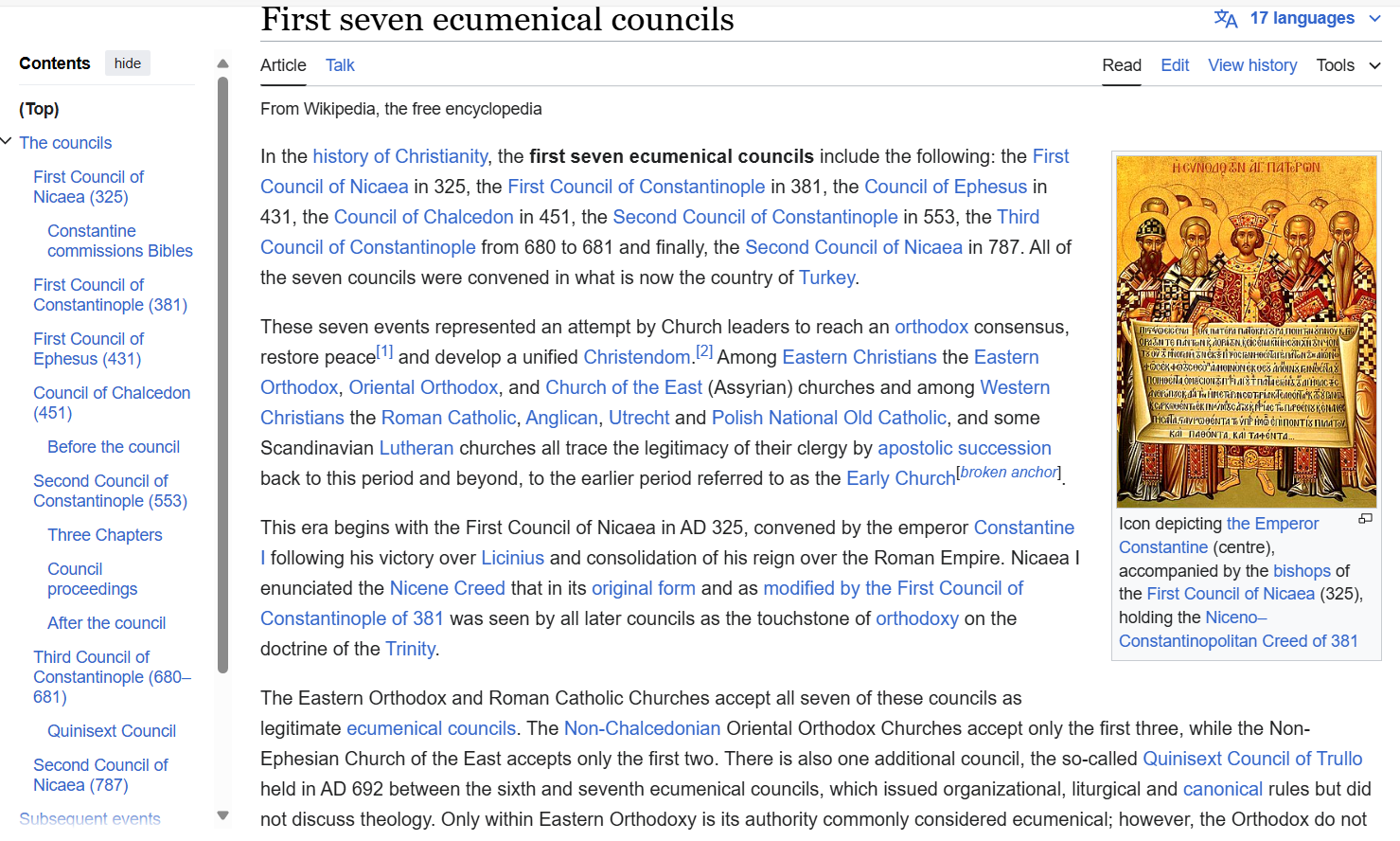
- The councils
- First Council of Nicaea (325)
- Constantine commissions Bibles
- First Council of Constantinople (381)
- First Council of Ephesus (431)
- Council of Chalcedon (451)
- Before the council
- Second Council of Constantinople (553)
- Three Chapters
- Council proceedings
- After the council
- Third Council of Constantinople (680–681)
- Quinisext Council
- Second Council of Nicaea (787)
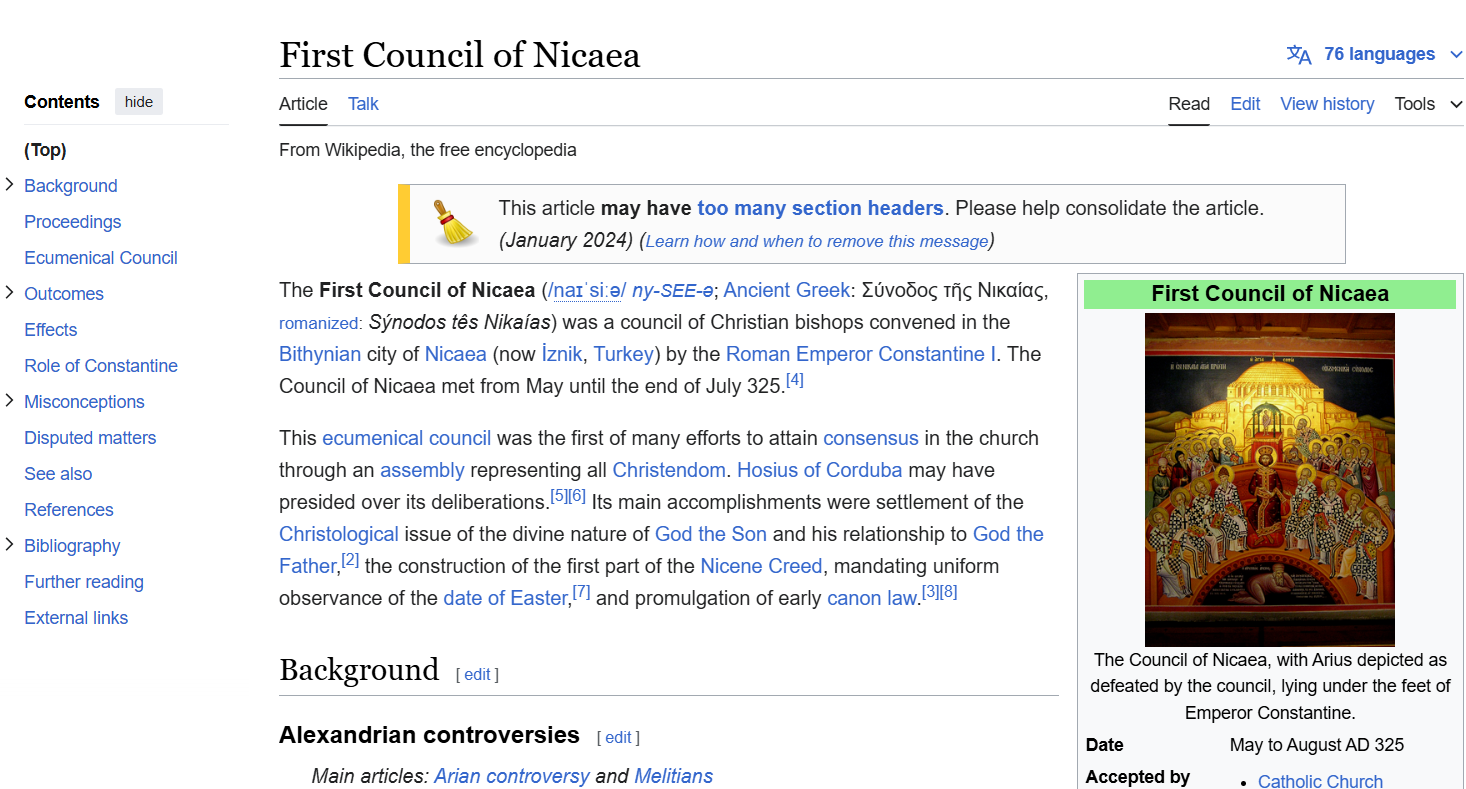
The First Council of Nicaea (/naɪˈsiːə/; Ancient Greek: Νίκαια [ˈnikεa]) was a council of Christian bishops convened in the Bithynian city of Nicaea (now İznik, Turkey) by the Roman Emperor Constantine I in AD 325.
This ecumenical council was the first effort to attain consensus in the church through an assembly representing all Christendom. Hosius of Corduba may have presided over its deliberations.[4][5] Its main accomplishments were settlement of the Christological issue of the divine nature of God the Son and his relationship to God the Father,[2] the construction of the first part of the Nicene Creed, mandating uniform observance of the date of Easter,[6] and promulgation of early canon law.[3][7]
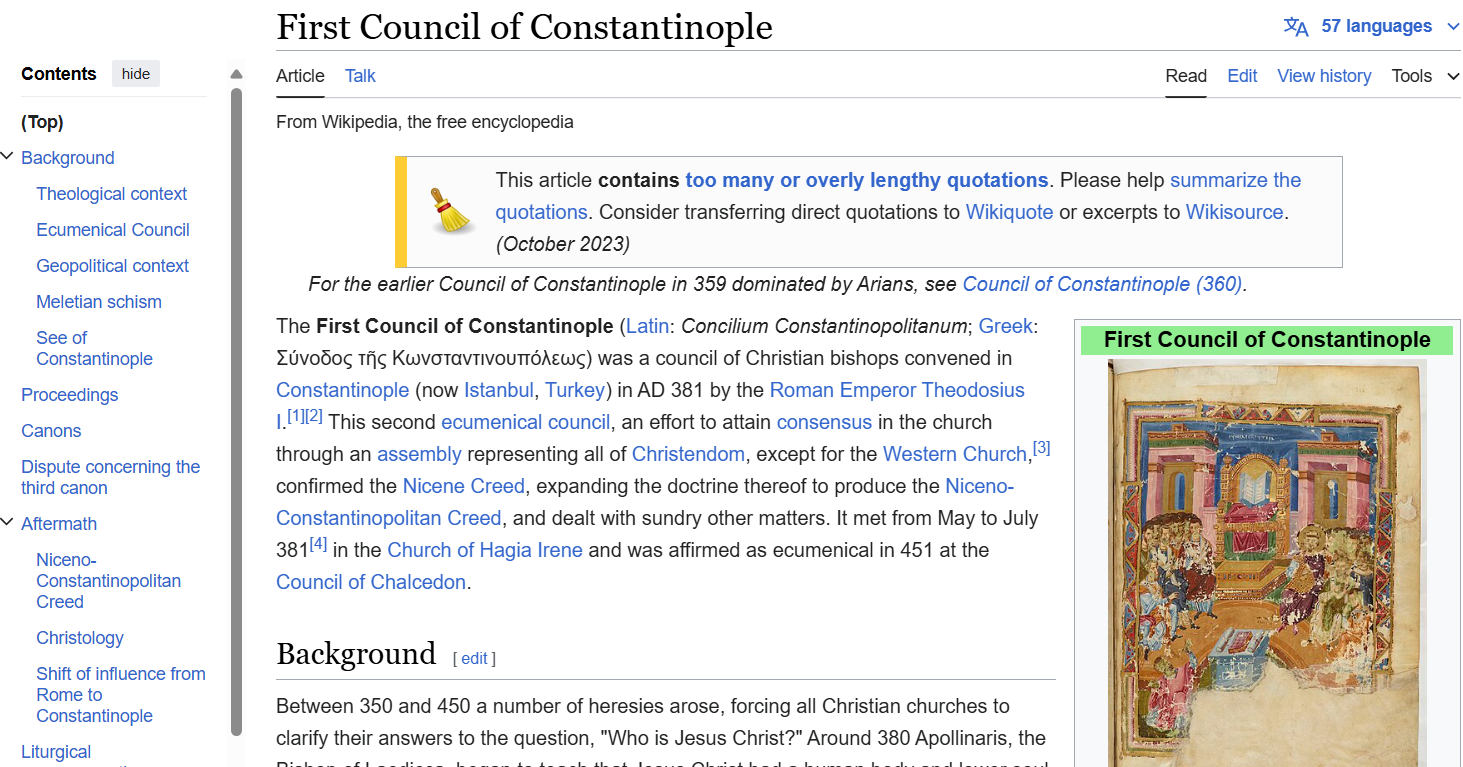
The First Council of Constantinople (Latin: Concilium Constantinopolitanum; Greek: Σύνοδος τῆς Κωνσταντινουπόλεως) was a council of Christian bishops convened in Constantinople (now Istanbul, Turkey) in AD 381 by the Roman Emperor Theodosius I.[1][2] This second ecumenical council, an effort to attain consensus in the church through an assembly representing all of Christendom, except for the Western Church,[3] confirmed the Nicene Creed, expanding the doctrine thereof to produce the Niceno-Constantinopolitan Creed, and dealt with sundry other matters. It met from May to July 381[4] in the Church of Hagia Irene and was affirmed as ecumenical in 451 at the Council of Chalcedon.
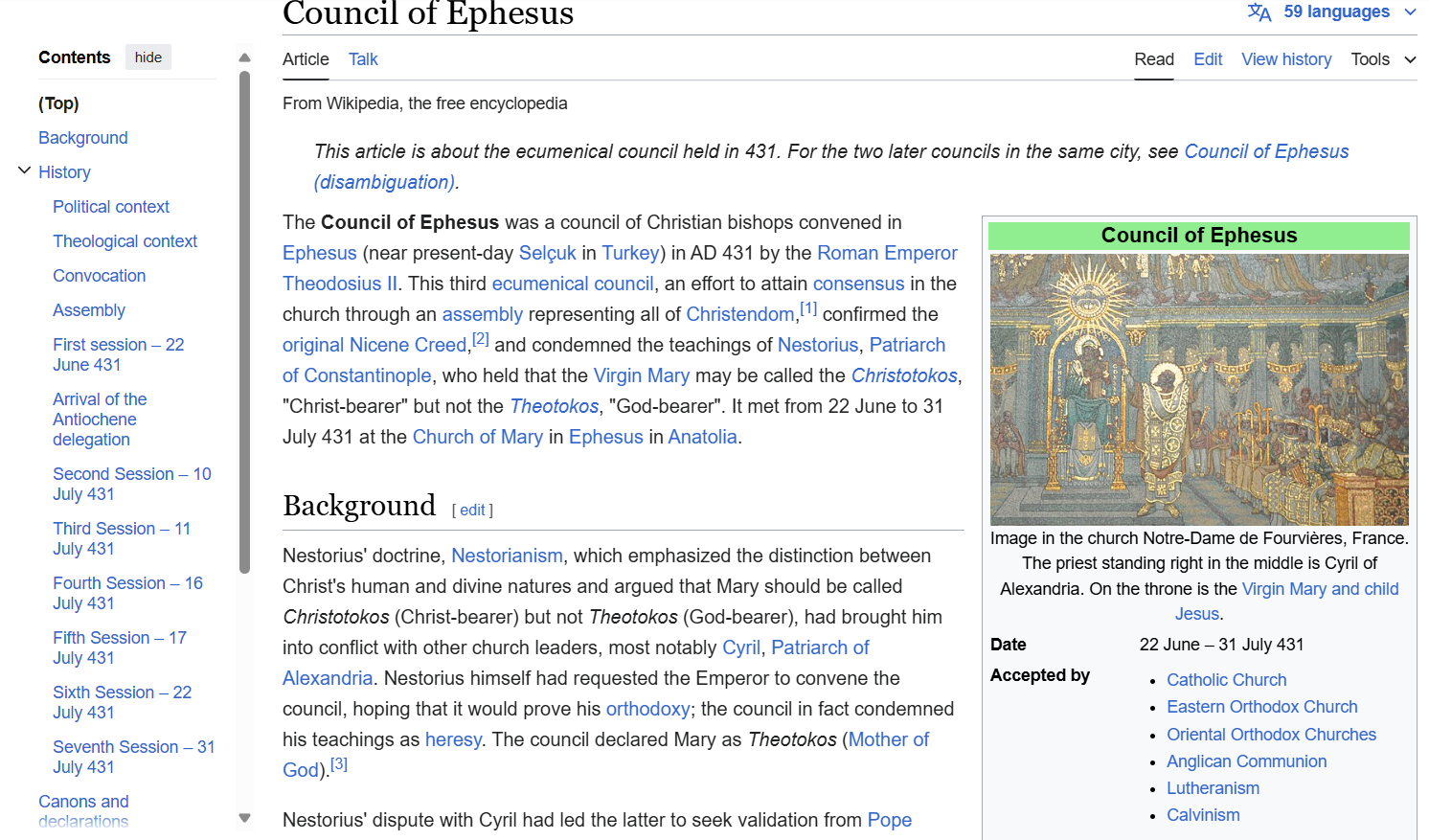
The Council of Ephesus was a council of Christian bishops convened in Ephesus (near present-day Selçuk in Turkey) in AD 431 by the Roman Emperor Theodosius II. This third ecumenical council, an effort to attain consensus in the church through an assembly representing all of Christendom,[1] confirmed the original Nicene Creed,[2] and condemned the teachings of Nestorius, Patriarch of Constantinople, who held that the Virgin Mary may be called the Christotokos, "Christ-bearer" but not the Theotokos, "God-bearer". It met in June and July 431 at the Church of Mary in Ephesus in Anatolia.
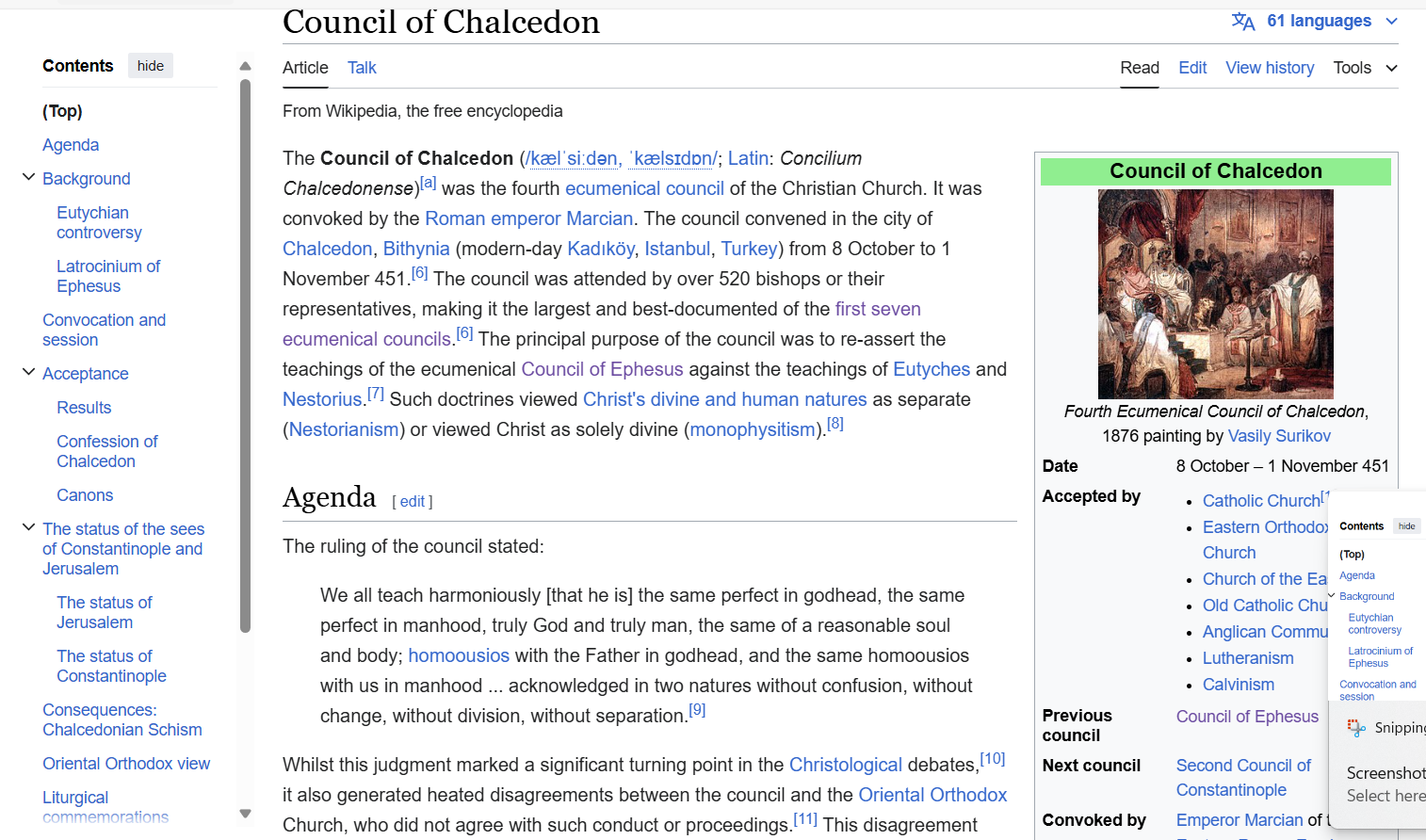
The Council of Chalcedon (/kælˈsiːdən, ˈkælsɪdɒn/; Latin: Concilium Chalcedonense; Greek: Σύνοδος τῆς Χαλκηδόνος, Synodos tēs Chalkēdonos) was the fourth ecumenical council of the Christian Church. It was convoked by the Roman emperor Marcian. The council convened in the city of Chalcedon, Bithynia (modern-day Kadikoy, Istanbul, Turkey) from 8 October to 1 November 451 AD.[1] The council was attended by 520 bishops or their representatives, making it the largest and best-documented of the first seven ecumenical councils.[1] The principal purpose of the council was to re-assert the teachings of the ecumenical Council of Ephesus against the heresies of Eutyches and Nestorius.[2] Such heresies attempted to dismantle and separate Christ's divine nature from his humanity (Nestorianism) and further, to limit Christ as solely divine in nature (Monophysitism).[3]
Before the council
In November 448, a synod at Constantinople condemned Eutyches for unorthodoxy.[17] Eutyches, archimandrite (abbot) of a large Constantinopolitan monastery,[18] taught that Christ was not consubstantial with humanity.[19]
In 449, Theodosius II summoned a council at Ephesus, where Eutyches was exonerated and returned to his monastery.[17] This council was later overturned by the Council of Chalcedon and labeled "Latrocinium" (i.e., "Robber Council").[17]
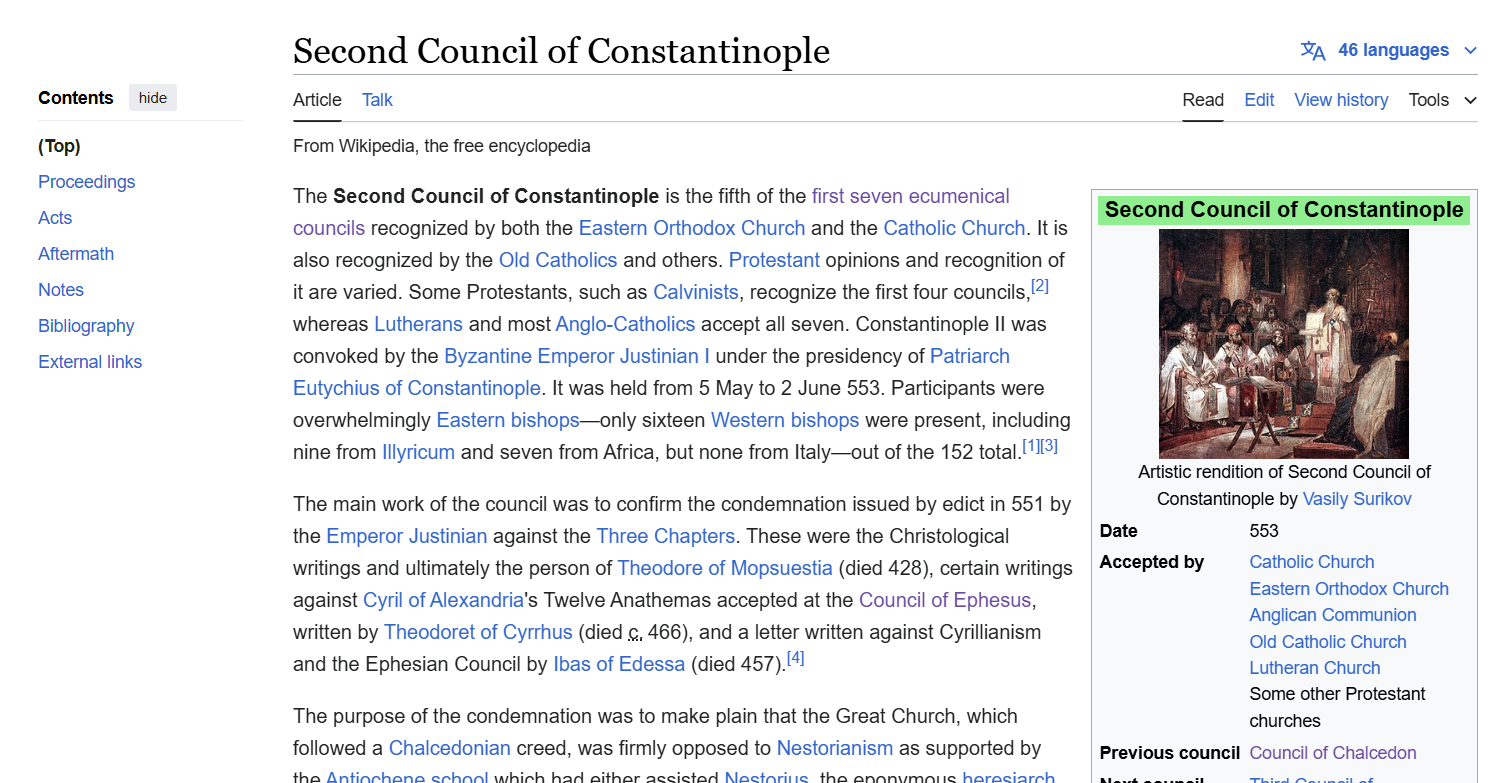
The Second Council of Constantinople is the fifth of the first seven ecumenical councils recognized by both the Eastern Orthodox Church and the Catholic Church. It is also recognized by the Old Catholics and others. Protestant opinions and recognition of it are varied. Some Protestants, such as Calvinists, recognize the first four councils,[2] whereas Lutherans and most Anglo-Catholics accept all seven. Constantinople II was convoked by the Byzantine Emperor Justinian I under the presidency of Patriarch Eutychius of Constantinople. It was held from 5 May to 2 June 553. Participants were overwhelmingly Eastern bishops—only sixteen Western bishops were present, including nine from Illyricum and seven from Africa, but none from Italy—out of the 152 total.[1][3]
The main work of the council was to confirm the condemnation issued by edict in 551 by the Emperor Justinian against the Three Chapters. These were the Christological writings and ultimately the person of Theodore of Mopsuestia (died 428), certain writings against Cyril of Alexandria's Twelve Anathemas accepted at the Council of Ephesus, written by Theodoret of Cyrrhus (died c. 466), and a letter written against Cyrillianism and the Ephesian Council by Ibas of Edessa (died 457).[4]
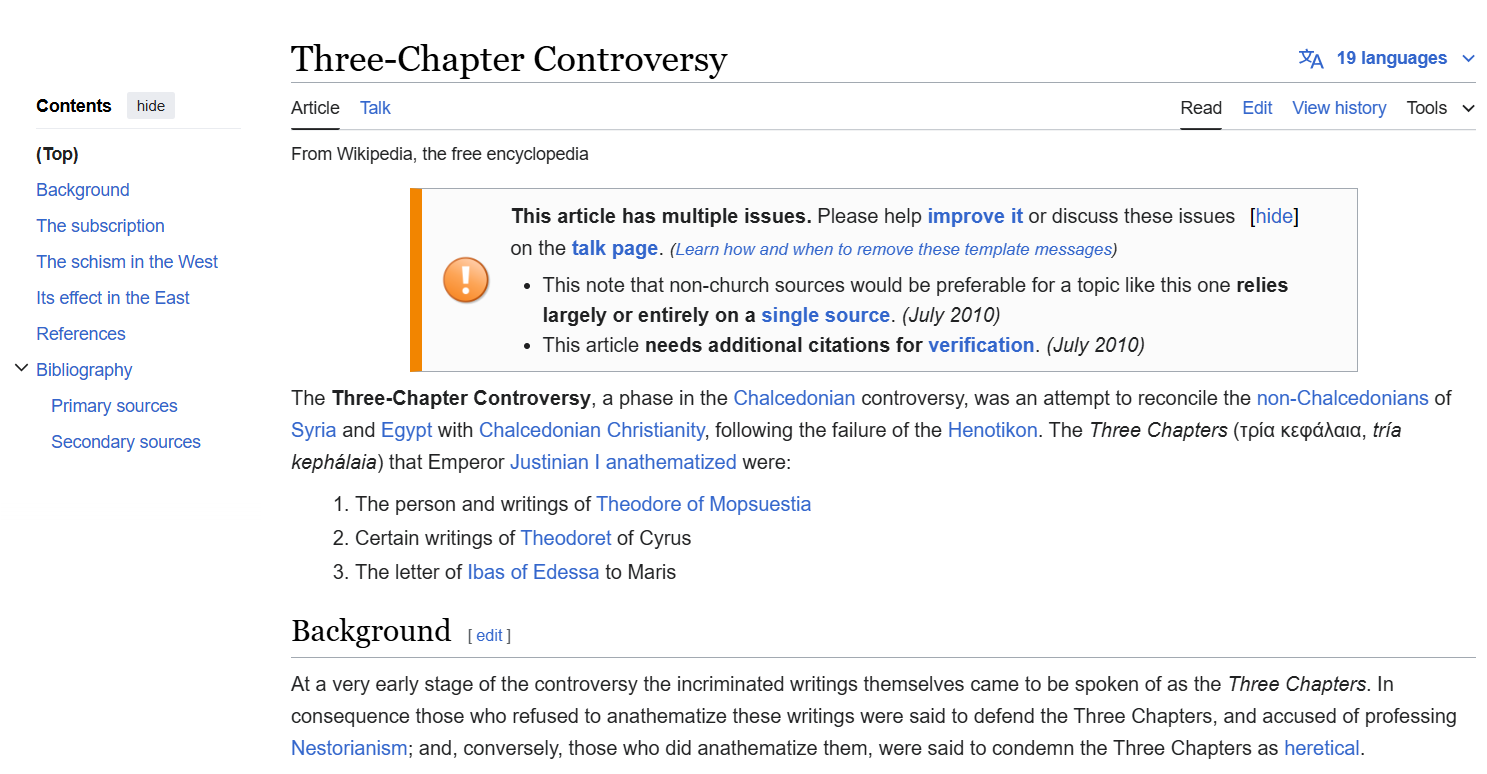
At a very early stage of the controversy the incriminated writings themselves came to be spoken of as the Three Chapters. In consequence those who refused to anathematize these writings were said to defend the Three Chapters, and accused of professing Nestorianism; and, vice versa, those who did anathematize them, were said to condemn the Three Chapters as heretical.
At the end of 543 or the beginning of 544 the Emperor Justinian I issued an edict in which the three chapters were anathematized, in hope of encouraging the Oriental Orthodox to accept the decisions of the Council of Chalcedon and the Tome of Pope Leo I, thus bringing religious harmony to the Byzantine Empire. However, Evagrius[1] tells us that Theodorus Ascidas, the leader of the Origenists, had raised the question of the Three Chapters to divert Justinian from a persecution of his party. Liberatus adds that Theodorus Ascidas wished to take revenge on the memory of Theodore of Mopsuestia, who had written much against Origen.[2] In his letter to Vigilius, Domitian, Bishop of Ancyra, reports the same story of intrigue.
Although Roman Catholic canonists admit that theological errors, and in the case of Theodore very serious ones, can be found in the writings, the mistakes of Theodoret and Ibas were chiefly but not wholly due to a misunderstanding of the language of Cyril of Alexandria. However these errors do not make the decision of condemnation easy, for there were no good precedents for dealing harshly with the memory of men who had died in peace with the Church. Facundus, Bishop of Hermiane, pointed out in his Defensio trium capitulorum that Saint Cyprian had erred about the rebaptism of heretics, yet no one would dream of anathematizing him. The condemnation of the "Three Chapters" was demanded primarily to appease opponents of the Council of Chalcedon. Both Ibas and Theodoret had been deprived of their bishoprics by condemned heretics, and both were restored by the Council of Chalcedon upon anathematizing Nestorius.
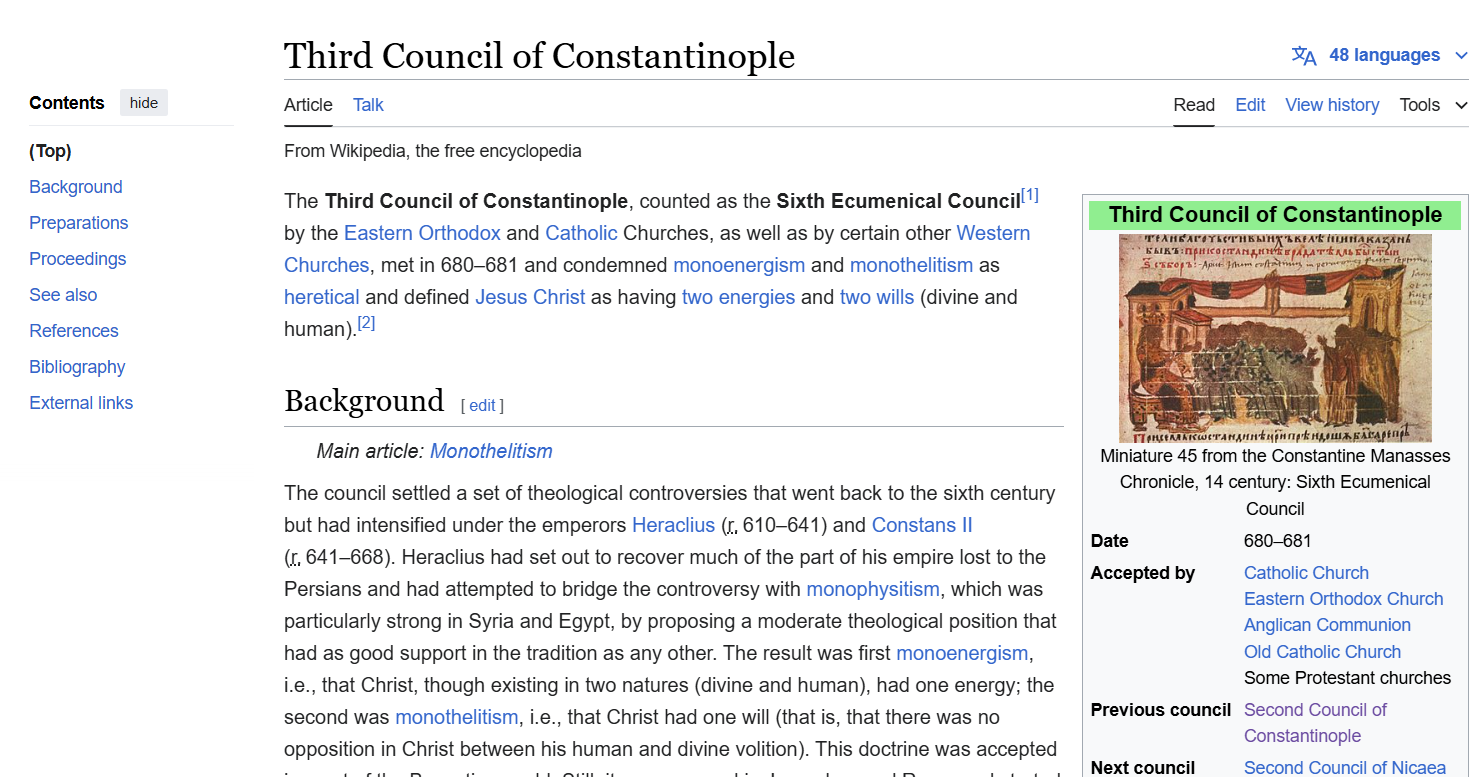
The Third Council of Constantinople, counted as the Sixth Ecumenical Council[1] by the Eastern Orthodox and Catholic Churches, as well by certain other Western Churches, met in 680–681 and condemned monoenergism and monothelitism as heretical and defined Jesus Christ as having two energies and two wills (divine and human).[2]
The council settled a set of theological controversies that went back to the sixth century but had intensified under the emperors Heraclius (r. 610–641) and Constans II (r. 641–668). Heraclius had set out to recover much of the part of his empire lost to the Persians and had attempted to bridge the controversy with monophysitism, which was particularly strong in Syria and Egypt, by proposing a moderate theological position that had as good support in the tradition as any other. The result was first monoenergism, i.e. that Christ, though existing in two natures (divine and human), had one energy, the second was monothelitism, i.e. that Christ had one will (that is, that there was no opposition in Christ between his human and divine volition). This doctrine was accepted in most of the Byzantine world but was opposed at Jerusalem and at Rome and started a controversy that persisted even after the loss of the reconquered provinces and the death of Heraclius. When Heraclius' grandson Constans II took the throne, he saw the controversy as threatening the stability of the Empire and attempted to silence discussion by outlawing speaking either in favour or against the doctrine.[3] Pope Martin I and the monk Maximus, the foremost opponents of monothelitism (which they interpreted as denying a human faculty of will to Christ), held a synod in Rome in 649 that condemned monoenergism and monothelitism.[4] At Constantinople in around 653, some accused the Pope of supporting revolution, this was regarded as high treason, and Martin was accordingly arrested, tried, condemned and sent into exile, where he soon died. Martin and Maximus's position was supported by others at the Council of Constantinople.[5][6]
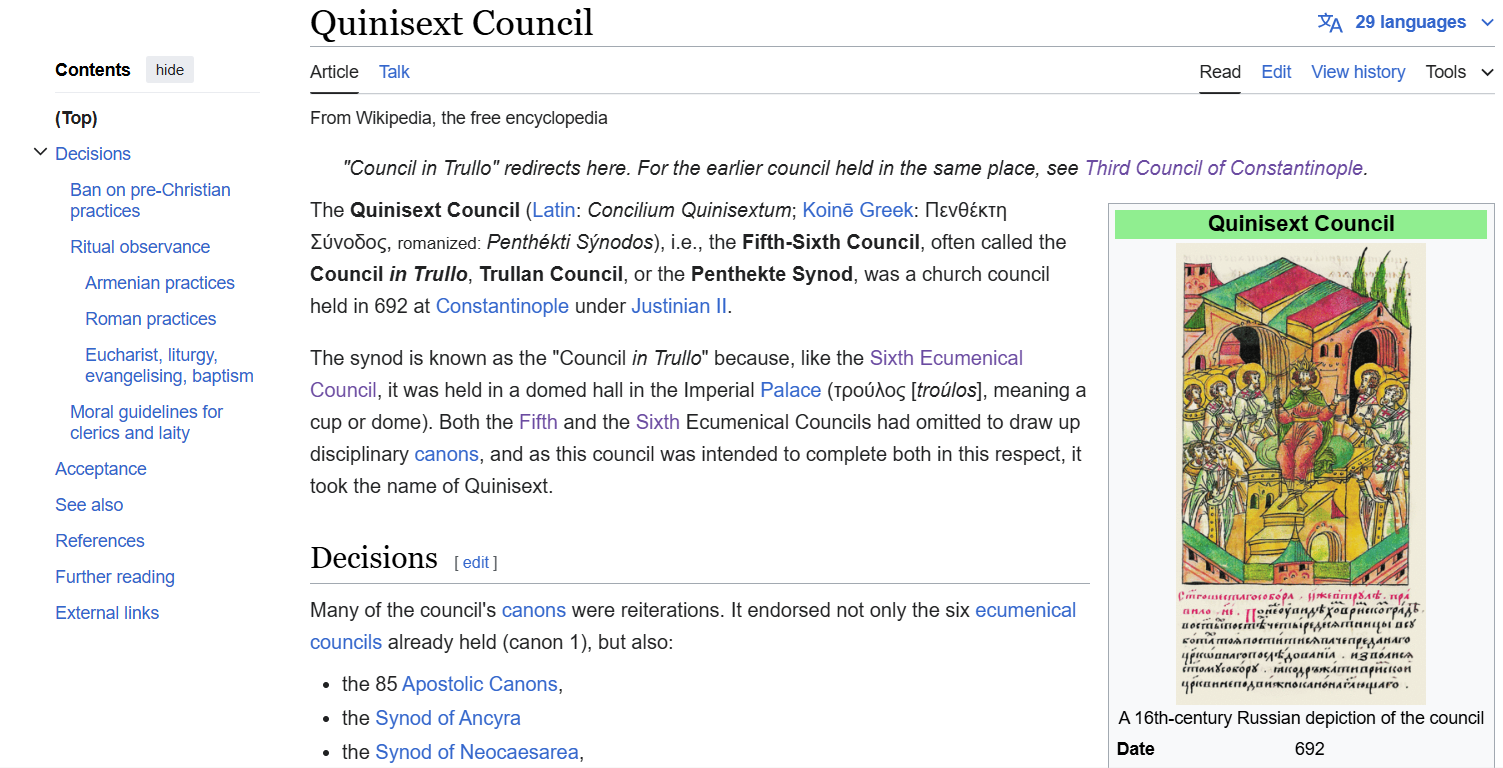
The Quinisext Council (Latin: Concilium Quinisextum; Koine Greek: Πενθέκτη Σύνοδος, Penthékti Sýnodos), i.e. the Fifth-Sixth Council, often called the Council in Trullo, Trullan Council, or the Penthekte Synod, was a church council held in 692 at Constantinople under Justinian II. It is known as the "Council in Trullo" because, like the Sixth Ecumenical Council, it was held in a domed hall in the Imperial Palace (τρούλος [troulos] meaning a cup or dome). Both the Fifth and the Sixth Ecumenical Councils had omitted to draw up disciplinary canons, and as this council was intended to complete both in this respect, it took the name of Quinisext. It was attended by 215 bishops, mostly from the Eastern Roman Empire. Basil of Gortyna in Crete belonged to the Roman patriarchate and called himself papal legate, though no evidence is extant of his right to use that title.
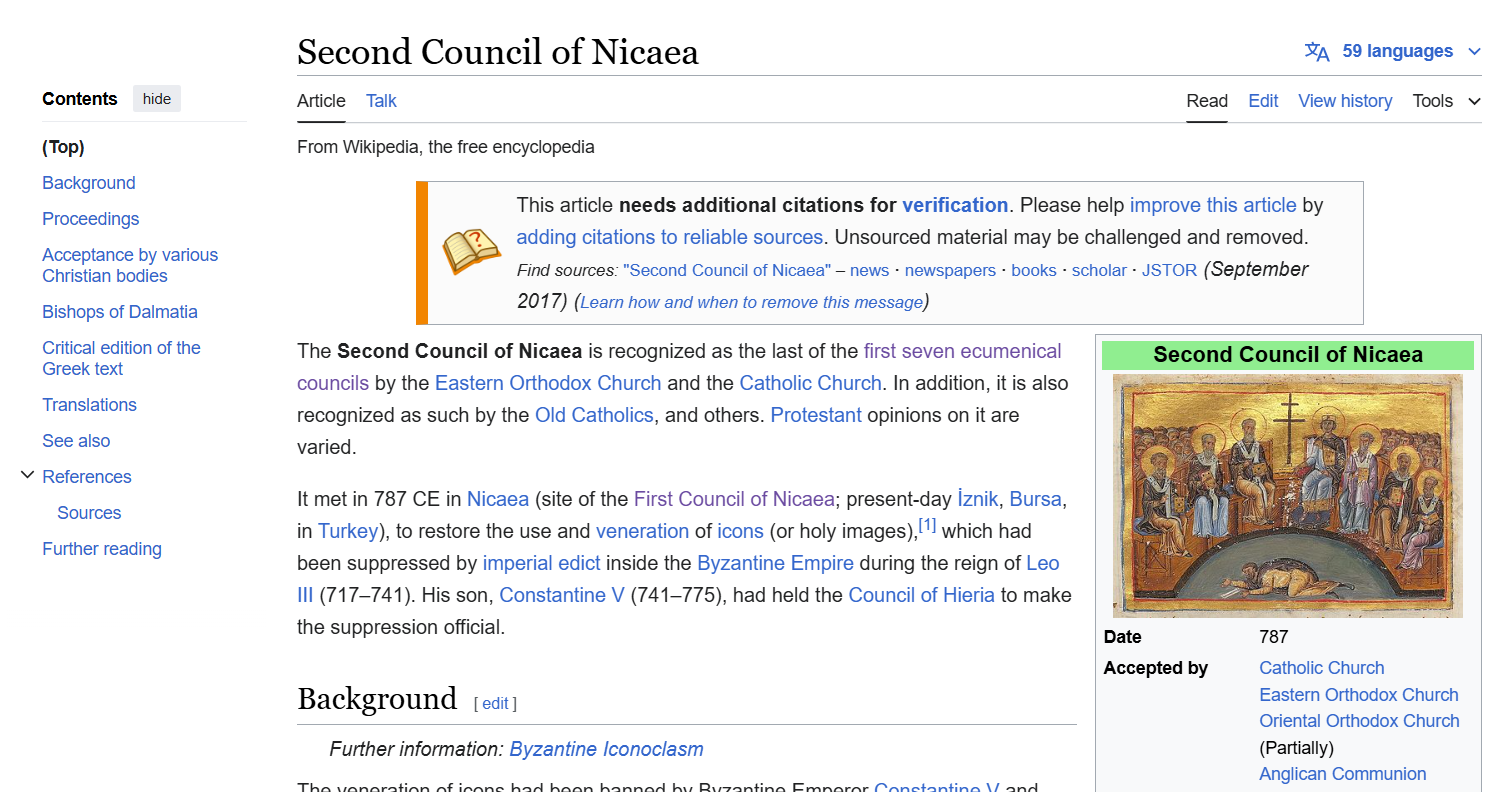
The veneration of icons had been banned by Byzantine Emperor Constantine V and supported by his Council of Hieria (754 AD), which had described itself as the seventh ecumenical council.[2] The Council of Hieria was overturned by the Second Council of Nicaea only 33 years later, and has also been rejected by Catholic and Orthodox churches, since none of the five major patriarchs were represented. The emperor's vigorous enforcement of the ban included persecution of those who venerated icons and of monks in general. There were also political overtones to the persecution—images of emperors were still allowed by Constantine, which some opponents saw as an attempt to give wider authority to imperial power than to the saints and bishops.[3] Constantine's iconoclastic tendencies were shared by Constantine's son, Leo IV. After the latter's early death, his widow, Irene of Athens, as regent for her son, began its restoration for personal inclination and political considerations.
In 784 the imperial secretary Patriarch Tarasius was appointed successor to the Patriarch Paul IV—he accepted on the condition that intercommunion with the other churches should be reestablished; that is, that the images should be restored. However, a council, claiming to be ecumenical, had abolished the veneration of icons, so another ecumenical council was necessary for its restoration.
Pope Adrian I was invited to participate, and gladly accepted, sending an archbishop and an abbot as his legates.